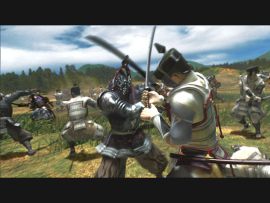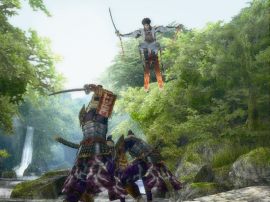Genji:
Dawn of the Samurai offers a unique blend of action and strategy that transports
players to feudal
Japan
. The game follows two young martial
artists with unique abilities as they face off against hordes of supernatural
foes who attack from all directions. Theyíre quite powerful, with incredible
swordplay and special attacks featuring multi-hit combos known as the Eihn.
These allow you to chain attacks and take out multiple foes with a few quick
button presses. Its intuitive controls and engrossing storyline makes for an
engaging experience games. Unfortunately, itís a bit short and most veteran
gamers will probably find it a bit limiting, but the intense plot and cool moves
definitely make Genji one of the better PS2 action titles on the market this
year.
Taking inspiration from the classic 11th Century Japanese literary
work Tale of Genji, considered by many to be the first novel, this exciting
release from SCEA and Game Republic delivers an authentic and exciting martial
arts experience that should please fans. Set in 1149 AD, Genji: Dawn of the
Samurai follows the adventures of a noble Samurai warrior named Yoshitune on a
quest to rid
Japan
of evil clan called the Heishi. The Heishi
have ruled the citizens of Kyo with an iron first, and banished the formerly
respected Genji clan to exile. They have become quite adept at keeping the
citizens at bay thanks to their use of powerful ancient stones and the powers
they contain. With his faithful companion, Benkai at his side, itís up to
Yoshitune to battle the Heishiís forces, liberate the citizens of Kyo and
restore the good name of his fallen clan. Genji features approximately 30 unique
missions, which offer plenty of variety and action through a variety of terrain.
 Genji:
Dawn of the Samuraiís design approach is highly reminiscent of the Onimusha
series, and features a similar feel and structure. While the action takes place
in 3D space, player movements are constricted on 3D planes with static
backdrops. This isnít the best solution, but it does lend itself to creating a
beautiful looking game world to explore. Every aspect of the game world, from
its architecture to itsí subtle seasonal changes fits together perfectly. From
a technical standpoint, Genjiís luscious visuals are excellent with natural
environments that cause the atmospherics to feel very much alive. The gameís
design is straightforward and the story unfolds inside a linear structure. There
is some breathing room and players have the opportunity to explore a richly
detailed game world filled with excitement and danger. The gameplay itself is
fluid and intuitive, so most players should be able to get right into the game
thanks to itsí smartly designed controls and easy to navigate item interface.
The tactical techniques at your disposal are powerful and authentic with the
swords and other weapons acting realistically in battle. As in many games of
this time, you can gradually increase your skills by defeating enemies,
collecting items and earning level-ups. The action switches between the two main
protagonists frequently, giving the narrative room to explore many facets of the
storyline. The plot itself unfolds during numerous cinematic cutscenes that are
quite elaborate, allowing the story to flow naturally and extensively between
battles. This helps further your identification with the main characters, and
keeps you motivated throughout your journey.
Genji:
Dawn of the Samuraiís design approach is highly reminiscent of the Onimusha
series, and features a similar feel and structure. While the action takes place
in 3D space, player movements are constricted on 3D planes with static
backdrops. This isnít the best solution, but it does lend itself to creating a
beautiful looking game world to explore. Every aspect of the game world, from
its architecture to itsí subtle seasonal changes fits together perfectly. From
a technical standpoint, Genjiís luscious visuals are excellent with natural
environments that cause the atmospherics to feel very much alive. The gameís
design is straightforward and the story unfolds inside a linear structure. There
is some breathing room and players have the opportunity to explore a richly
detailed game world filled with excitement and danger. The gameplay itself is
fluid and intuitive, so most players should be able to get right into the game
thanks to itsí smartly designed controls and easy to navigate item interface.
The tactical techniques at your disposal are powerful and authentic with the
swords and other weapons acting realistically in battle. As in many games of
this time, you can gradually increase your skills by defeating enemies,
collecting items and earning level-ups. The action switches between the two main
protagonists frequently, giving the narrative room to explore many facets of the
storyline. The plot itself unfolds during numerous cinematic cutscenes that are
quite elaborate, allowing the story to flow naturally and extensively between
battles. This helps further your identification with the main characters, and
keeps you motivated throughout your journey.
While
your standard attacks can get you through some basic battles, youíll need
additional powers to defeat the more challenging foes youíll face. In order to
kill foes attacking all at once, youíll need to master the art of the multiple
attack, called the Kumai. At the start of your adventure, you can go through a
quick tutorial that on the ways of the Kumai. Youíll learn that these special
abilities allow you to slow down the action to strike down multiple opponents
with a single move. This is quite effective, especially once you can get the
timing right. Itís a relatively simple process once you get the hang of it but
it takes some practice. You charge the Kumai move by holding the L1 button. Once
you do this, the action switches to another angle, and this new perspective
allows you to see your foes in isolation. Further helping is the fact that time
slows down, allowing you to focus your attacks. This also causes a cool effect
that makes the environments blur and swirl around you, as a dream.
 Once
Kumai is enabled, you need to press the square button at a certain moment before
the enemies attack you. Successfully downing one foe allows you to move onto the
next opponent. You can chain these
Kumai attacks together to take out a series of opponents while limiting your
exposure to their attacks and any damage. While you canít use this technique
in every encounter, itís most effective when youíre surrounded by multiple
opponents. Your foes are relentless and attack you from all directions. However,
the deep moves list offers complexity and the intensity of each battle makes
Genji and exciting title that offers plenty of swordplay. The gameís levels
offer a good mix of standard enemies, which are easy to attack, and tougher
bosses and sub-bosses. The overall design of Genjiís attack system is
impressive, but the balance isnít as good in practice as it sounds on paper.
Unfortunately, the level of difficulty in the game isnít as high as youíd
expect it to be. Once you have mastered the Kumai moves, most of the foes pose
little threat, making many battles become too easy, allowing you to slice
through enemies effortlessly. Furthermore, the enemy AI ranges from predictable
for most standard foes to moderatedly challenging for the bosses, making this a
title you can finish completely quickly. On the other hand, Itís accessible
controls and simple structure means casual players should have a good time with
the game. In order to compensate for the shallow gameplay, Genji features a deep
upgrade and customization system that adds some replay value and a little more
depth to the experience.
Once
Kumai is enabled, you need to press the square button at a certain moment before
the enemies attack you. Successfully downing one foe allows you to move onto the
next opponent. You can chain these
Kumai attacks together to take out a series of opponents while limiting your
exposure to their attacks and any damage. While you canít use this technique
in every encounter, itís most effective when youíre surrounded by multiple
opponents. Your foes are relentless and attack you from all directions. However,
the deep moves list offers complexity and the intensity of each battle makes
Genji and exciting title that offers plenty of swordplay. The gameís levels
offer a good mix of standard enemies, which are easy to attack, and tougher
bosses and sub-bosses. The overall design of Genjiís attack system is
impressive, but the balance isnít as good in practice as it sounds on paper.
Unfortunately, the level of difficulty in the game isnít as high as youíd
expect it to be. Once you have mastered the Kumai moves, most of the foes pose
little threat, making many battles become too easy, allowing you to slice
through enemies effortlessly. Furthermore, the enemy AI ranges from predictable
for most standard foes to moderatedly challenging for the bosses, making this a
title you can finish completely quickly. On the other hand, Itís accessible
controls and simple structure means casual players should have a good time with
the game. In order to compensate for the shallow gameplay, Genji features a deep
upgrade and customization system that adds some replay value and a little more
depth to the experience.
Genjiís basic move sets and weapons let you cut through your enemies easily;
players can purchase numerous upgrades and items as they progress through the
game to enhance their characterís abilities and power. Since every playable
character has a unique fighting style and moves set, you can replay the levels
with different results, or go back and try a frustrating area again with another
character. As the characters evolve, theyíll learn new skills that can let
them defeat previously unbeatable foes, which increases Genjiís replayability
substantially. This upgrade system is quite extensive and your character can be
enhanced with additional strength, defense, and health points, in addition to
the more standard weapons, armor and strength. However, as these aspects
increase, the dexterity, and danger of your foes is enhanced as well. In
addition, players can track their growth and changes throughout their adventure
with additional cinematic sequences that further flesh out their new abilities,
making Genji resemble almost an interactive movie at certain points.
 From an
aesthetic standpoint, Genji stands out from the pack by offering some of the
more robust environments seen on the PS2. The look and feel of the world is
quite believable throughout, and the worlds change and mutate with the seasons,
adding to the realism. Sadly, the gameís visuals suffer from excessive jaggies
and some camera issues at certain points that detract from an otherwise
excellent game. However, Geniiís imaginative character designs are excellent,
with many featuring elaborate feudal-era costumes that showcase plenty of
detail. You encounter both human and demonic foes but, the consistent design
makes this feel believable throughout. The evocative score, dialogue and, sound
effects blend together effortlessly with the feel and pacing of the action,
making Genji sound as good as it looks. Technicaly, the game is solid since most
action occurs in a third-person perspective, so you donít have to mess with
the camera. Thereís also a lock-on feature that you can use to locate enemies
in the game and keep them in range. Genjiís cinemas do an excellent job of
fleshing out the story and bringing the characters to life. The voice-overs are
in Japanese, with subtitles, and the music is excellent, with a traditional
Eastern score creating an excellent mood throughout. Despite a few flaws and
glitches, Genjiís overall design exceeds expectations. A good mix of
traditional storytelling and fast combat action gives the game an excellent
pace, making it accessible and enjoyable to play for players of different
abilities.
From an
aesthetic standpoint, Genji stands out from the pack by offering some of the
more robust environments seen on the PS2. The look and feel of the world is
quite believable throughout, and the worlds change and mutate with the seasons,
adding to the realism. Sadly, the gameís visuals suffer from excessive jaggies
and some camera issues at certain points that detract from an otherwise
excellent game. However, Geniiís imaginative character designs are excellent,
with many featuring elaborate feudal-era costumes that showcase plenty of
detail. You encounter both human and demonic foes but, the consistent design
makes this feel believable throughout. The evocative score, dialogue and, sound
effects blend together effortlessly with the feel and pacing of the action,
making Genji sound as good as it looks. Technicaly, the game is solid since most
action occurs in a third-person perspective, so you donít have to mess with
the camera. Thereís also a lock-on feature that you can use to locate enemies
in the game and keep them in range. Genjiís cinemas do an excellent job of
fleshing out the story and bringing the characters to life. The voice-overs are
in Japanese, with subtitles, and the music is excellent, with a traditional
Eastern score creating an excellent mood throughout. Despite a few flaws and
glitches, Genjiís overall design exceeds expectations. A good mix of
traditional storytelling and fast combat action gives the game an excellent
pace, making it accessible and enjoyable to play for players of different
abilities.
While the gameís design is solid, some significant issues detract from the
overall experience. The linear gameplay is exciting at first, but the
low-challenge level of the enemy AI makes the game far too easy, once you get
the hang of the controls. Standard combat should pose few problems for most
players, but the Kumai system, can be confusing to use and demands exacting
timing. Once you get the hang of it however, this special attack allows you to
go through foes with little effort, undermining a key aspect of the gameplay.
While the design and concept behind the game is excellent, the visuals suffer
from jaggies and the design never quite allows you to suspend disbelief as you
play and move on predefined planes and areas. Despite thee problems, Genji: Dawn
of the Samurai is still an impressive martial arts title. It features plenty of
intense battles, fluid controls and an interesting storyline that should satisfy
fans of the genre. Genji probably wonít win any awards for innovation, bearing
much of Onimushaís imprint, this is still a solidly entertaining title that
succeeds in mxing action and story without making too many compromises along the
way. While itís not the most original or polished title on the PS2, this is an
entertaining title that players who enjoyed Onimusha will find familiar yet
satisfying.

